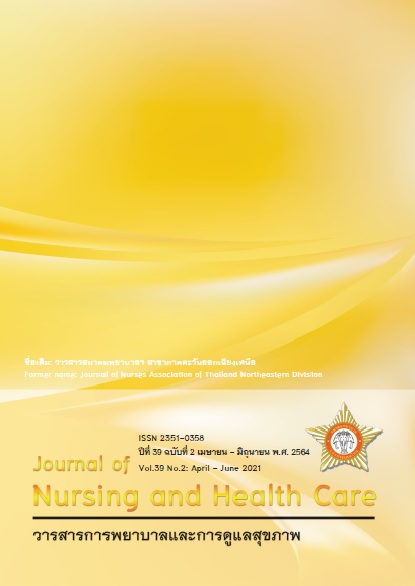การพัฒนารูปแบบการดูแลต่อเนื่องในผู้ป่วยที่ต้องดูแลเป็นพิเศษเขตอำเภอเมืองเลย
คำสำคัญ:
การพัฒนารูปแบบ, การดูแลต่อเนื่อง, ผู้ป่วยที่ต้องดูแลเป็นพิเศษบทคัดย่อ
การวิจัยเชิงปฏิบัติการนี้ มีวัตถุประสงค์เพื่อพัฒนารูปแบบการดูแลต่อเนื่องสำหรับผู้ป่วยที่ต้องดูแลเป็นพิเศษ ผู้ร่วมวิจัยเป็น แพทย์ 1 คน พยาบาลจากหอผู้ป่วยและเครือข่ายปฐมภูมิ 30 คน นักกายภาพบำบัด 2 คน และนักวิชาการคอมพิวเตอร์ 2 คน ระยะเวลาศึกษา 8 เดือน (กรกฎาคม พ.ศ.2563 ถึง กุมภาพันธ์ พ.ศ. 2564) โดยการแลกเปลี่ยนประสบการณ์และสะท้อนคิด เพื่อสร้างความตระหนักและร่วมกันพัฒนารูปแบบ แบ่งเป็น 2 วงรอบ คือ การพัฒนารูปแบบการดูแลต่อเนื่อง และการปรับใช้รูปแบบดังกล่าวในงานประจำ แต่ละวงรอบมี 4 ขั้นตอน ได้แก่ 1) การวางแผน โดยวิเคราะห์สถานการณ์ด้วยการสัมภาษณ์เชิงลึกและการสนทนากลุ่ม วางแผนพัฒนารูปแบบด้วยการประชุมระดมสมองและสะท้อนคิด 2) ปฏิบัติการ โดยนำรูปแบบดังกล่าวไปปฏิบัติ 3) สังเกตการณ์ โดยรวบรวมข้อมูลจากโปรแกรม Thai COC และเวชระเบียน และ 4) การสะท้อนคิด ทบทวนรูปแบบและวางแผนปรับปรุงในวงรอบต่อไป ผลลัพธ์ เกิดรูปแบบและแนวทางการดูแลต่อเนื่องในผู้ป่วยกลุ่มดังกล่าว มีการส่งต่อข้อมูลผู้ป่วยภายใน 5 วัน เพิ่มขึ้นอย่างมีนัยสำคัญทางสถิติ (p< 0.001) ผู้ป่วยได้รับการดูแลสุขภาพที่บ้านเพิ่มขึ้นอย่างมีนัยสำคัญทางสถิติ (p= 0.001) ผู้ป่วยมีอาการดีขึ้นอย่างมีนัยสำคัญทางสถิติ (p= 0.025) สรุปได้ว่า รูปแบบดังกล่าวช่วยให้เกิดการมีส่วนร่วมตั้งแต่การวางแผนจำหน่ายผู้ป่วย การจัดสิ่งแวดล้อมที่เอื้อต่อการดูแลตนเองที่บ้าน ช่วยให้ครอบครัวมีความมั่นใจในการดูแลผู้ป่วยที่บ้าน และการใช้โปรแกรม Thai COC เป็นช่องทางการสื่อสารทำให้เครือข่ายมีการดูแลต่อเนื่องทันเวลาและครอบคลุมมากขึ้น
Downloads
เอกสารอ้างอิง
2. Jenjaiwit P. Family nursing for family with chronic illness person: Part 1 continuity of care concept. Journal of Nursing Science and Health 2017; 40(3). 138-148.
3. Uijena AA, Schersa HJ, Schellevisb FG. How unique is continuity of care? A review of continuity and related concepts. Family Practice 2012; 29(1): 264–271.
4 Mahantussanapong C. Successful increase in home visit care response rates by using an information program for continuum of care. J Prapokklao Hosp Clin Med Educat Center 2018; 35(4): 355-363.
5. Sukhumanpitak J, Nantsupawat W, Hornboonherm P. Development of a care model for male stroke patients in secondary hospital using a participatory action research. Journal of nurses’ association of Thailand, Northeastern division 2012; 30(1): 32-39.
6. Nikomrack W, Jenijaiwit P. Development of continuing care service system for families with stroke patients. Journal of nursing science and health 2015; 38(1): 108-122.
7. Kemmis, S. & McTaggart, R. (1990). Action Research Reader. Geelong: Deakin University Press.
8. Attharos T, Arpaichiratana C. Model of Continuing Care for Chronically Ill Children. The journal of nursing council 2011; 26(1): 112-125.
9. Boonles P, Proarak T, Thaewpia S. Continuous care model development for disability elders in Bandongmone health promotion hospital Tumbon Singkok Aumphur Kasetwisai Roi-Et Province. Journal of the office of ODPC 7 Khon Kaen; 23(2): 79-87.
10. Rattanagreethakul S, Thanakit S, Krungkraipetch N, Ritngam A. Development of the Home Ward Care: A Case Study of the Health Promoting Innovation of Khlong-Yai Hospital, Trat Province. The Journal of Faculty of Nursing Burapha University 2018; 26(1): 70-80.
11. Atthawong P, Anusornprasert N, Sardlee. Home nursing care for bed ridden patients from primary care unit. The southern college network journal of nursing and public health 2020; 4(1): 73-85.



